Light rail in Sydney
The Sydney light rail network (or Sydney Light Rail) is a light rail system serving the Australian city of Sydney, New South Wales. The network currently consists of three passenger routes, the L1 Dulwich Hill, L2 Randwick and L3 Kingsford lines. A separate light rail network serving Western Sydney called Parramatta Light Rail is also under construction as of 2020, and is scheduled for completion in 2023.
 | |
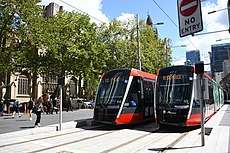 Alstom Citadis 305s in Sydney's CBD | |
 System icon | |
| Overview | |
|---|---|
| Owner | Transport for New South Wales |
| Locale | Sydney, New South Wales |
| Transit type | Light rail |
| Number of lines | 3 |
| Number of stations | 42 |
| Annual ridership | 12.3 million (2019–20) |
| Website | TfNSW Light Rail |
| Operation | |
| Began operation | August 31, 1997 |
| Operator(s) | Transdev Sydney |
| Number of vehicles | 60 Alstom Citadis 305 light rail vehicles 12 Urbos 3 light rail vehicles |
| Technical | |
| System length | 24.7 km (15 mi)[1] |
| Track gauge | 1,435 mm (4 ft 8 1⁄2 in) standard gauge |
| Electrification | 750 V (DC) overhead line Ground-level power supply between Town Hall and Circular Quay |
| Top speed | 70 km/h (43 mph)[2] |
The network is controlled by Transport for NSW, with day-to-day operation contracted to Transdev. In the financial year ended June 2020, 12.3 million passenger journeys were made on the network.
History
In the 19th and early 20th centuries, Sydney developed an extensive tram network, which grew to be the second largest in the Southern Hemisphere and second largest in the Commonwealth after London. The increasing rate of private car ownership, perception that trams contributed to traffic congestion and the general rundown conditions of the network due the lack of funding after World War II led to the progressive replacement of tram services with buses, with the final section of the tram network closing on 25 February 1961.
.jpg)
In the 1980s and 1990s, the inner city areas of Darling Harbour and Pyrmont were the subject of an urban renewal program. In 1988 the Sydney Monorail opened, connecting Darling Harbour to the central business district. With poor integration between the monorail and other transport modes, and the increasing redevelopment of the Pyrmont peninsula – including the establishment of Sydney's first legal casino – it was decided to convert a disused section of the Metropolitan Goods railway line into a light rail line. A section of track between Pyrmont and Haymarket was upgraded and a new on-street section was built to link the line to Central railway station. The line was set up as a public-private partnership. It opened in August 1997, running between Central station and Wentworth Park, Pyrmont.
The private owner soon made proposals for a western extension continuing along the disused goods line, plus a new line through the central business district from Central to Circular Quay.[3] The western extension opened in 2000, terminating at Lilyfield, but the company was unsuccessful in its attempts to develop a CBD line, which saw development of light rail stagnate for the remainder of the decade.
By contrast, the 2010s have seen major expansion and reform of light rail in Sydney including the announcement and delivery of multiple new infrastructure projects, integration of ticketing with the city's other transport modes, the introduction of new trams and the transfer of the network to full public ownership. The extensions announced during the decade total almost 40 km (25 mi). If all projects are completed, the network would expand in size from 7.2 km (4.5 mi) at the start of the decade to approximately 50 km (30 mi).
Ownership and operation
Public-private partnership
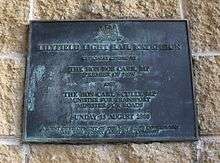
In March 1994 the Sydney Light Rail Company (SLRC) was formed. SLRC was awarded a 30-year concession to operate the light rail system until February 2028 when ownership would pass to the New South Wales Government.[4] The contract gave the company significant control over the commercial arrangements relating to future extensions or interconnecting lines.[5] Operation of the line was contracted to TNT Transit Systems, which also owned the Sydney Monorail.[6]
The SLRC purchased TNT Transit Systems in August 1998 as part of a joint venture with French transport company CGEA Transport.[7][8] This resulted in CGEA Transport taking over the light rail operating contract. CGEA Transport and its successors have operated the inner city light rail network ever since.[9]
In early 2001, Connex (renamed from CGEA Transport in 1999) sold its share of the monorail to the SLRC, bringing the monorail and light rail under unified ownership and leading to the formation of Metro Transport Sydney.[10][11]
The New South Wales Government purchased Metro Transport Sydney in March 2012, and the company was placed under the control of Transport for NSW.[12] The purchase removed the contractual restrictions on expanding the light rail network and allowed the government to dismantle the monorail, assisting its plans to redevelop the Sydney Convention & Exhibition Centre.[13][14]
Government ownership
From 1 July 2013, the Metro Light Rail brand was phased out as part of a broader rebranding and reorganisation of public transport services in New South Wales.[15] The process of shutting down Metro Transport Sydney and transferring assets to Transport for NSW was completed in September 2014.[16]
Following the announcement of the CBD and South East Light Rail, the government decided to group the contract covering construction of the new line with the operation and maintenance both lines of the inner city network. In December 2014, Transport for NSW awarded the contract to the ALTRAC Light Rail consortium. This sees Transdev Sydney, the operator under the previous contract, continue to operate and maintain the network as part of the consortium.[17] The operating contract commenced on 1 July 2015 and runs until 2034.[18][19]
After taking control of the Inner West Light Rail and announcing the CBD and South East Light Rail, the government also moved to establish a separate network centred around the Western Sydney suburb of Parramatta. Transdev will also operate the Parramatta network as part of the Great River City Light Rail consortium. This contract runs for eight years from construction completion, with a possible extension of up to an additional ten years.[20]
Operations
Network
Sydney's light rail network consists of:
- Inner West Light Rail – serviced by L1 Dulwich Hill Line
- CBD and South East Light Rail – serviced by L2 Randwick Line and L3 Kingsford Line
- Parramatta Light Rail (under construction, stage 1 to open 2023)
L1 Dulwich Hill Line
The L1 Dulwich Hill Line is the network's original passenger route, first commenced in August 1997. It operates along the 12.8-kilometre (8 mi) Inner West Light Rail between Central station and Dulwich Hill, stopping at 23 stations along the route. It connects Sydney's Inner West with the Pyrmont peninsula, Darling Harbour and at the southern end of the central business district.
Majority of the Inner West Light Rail line is along the alignment of a former freight railway line, with a short on-street section at the city end. The line opened between Central railway station in the city and Wentworth Park, Pyrmont in August 1997,[21] then extended west to Lilyfield in August 2000, and then south-west to Dulwich Hill in March 2014.[22][23]
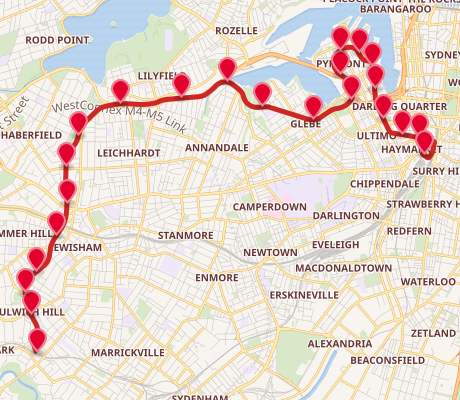
L2 Randwick & L3 Kingsford Lines
The L2 Randwick Line and L3 Kingsford Line are Sydney's newest passenger routes on the Sydney light rail network. L2 Randwick Line services commenced on 14 December 2019, while L3 Kingsford Line services commenced operations on 3 April 2020.[24][25] They operate on the CBD and South East Light Rail, between Circular Quay at the northern end of the central business district to Central station at the southern end, then continuing to the south-eastern suburbs.
CBD and South East Light Rail was built to reduce bus congestion in the CBD and provides higher capacity public transport to the Sydney Football Stadium (2022), Sydney Cricket Ground, Randwick Racecourse and the University of New South Wales, which were previously served only by buses. In contrast to the Inner West Light Rail, the line is mostly on-street and follows a similar path to routes used by the former tramway network. Major construction began in October 2015.[26]

Under construction
Parramatta lines
Parramatta Light Rail is the name given to two planned lines that converge on the Western Sydney centre of Parramatta.
The first line runs from Carlingford to Westmead via the Parramatta CBD. It includes the conversion of most of the former heavy rail Carlingford line to light rail standards. Construction began in 2018 and is expected to be completed by 2023.[27][28]
The preferred route for the second line was announced in October 2017. This line branches from the first line at Rydalmere and travels through Ermington, Melrose Park, Wentworth Point and on to the Sydney Olympic Park events precinct.[29]
The lines will have no connection to the Inner West or CBD and South East lines.
Rolling stock
All services were previously operated by a single class of tram. A second class was added to the fleet to operate services on the CBD and South East Light Rail. All vehicles to have operated on the system have been articulated, low floor and bi-directional. The system uses standard gauge track and 750 volt direct current electrification.
Urbos 3
Inner West Light Rail
.jpg)
Following the 5.6 km extension of the Inner West Light Rail to Dulwich Hill, more rolling stock was needed to support services and run alongside the Variotrams that had been providing services on the line since the first section opened in 1997.[30] A tender for six Urbos 3s was awarded to Spanish company Construcciones y Auxiliar de Ferrocarriles (CAF) on 16 August 2012.[31] The first unit arrived in Sydney on 19 December 2013 and entered service on 24 July 2014.[32][33] All were in service by August, allowing the leased Urbos 2s to be returned to Spain.[30]
On 11 October 2013, the Government announced an order for six additional Urbos 3s to replace the Variotrams.[34] All Urbos 3s from the additional order had entered service by the end of June 2015.[17][35]
The Urbos 3s are approximately 33 metres long and feature two double and two single doors on each side. The seats on the first batch are generally in the transverse configuration – at 90 degrees to the sides of the vehicle.[36] The second batch replace some of the transverse seats with longitudinal seating, providing more standing room. Digital voice announcements and internal dot-matrix displays provide information about the next stop. They have a standard capacity of 206 passengers and a crush capacity of 272.[37] The vehicles are numbered 2112, 2114–2124.
Parramatta Light Rail
Stage 1 of the Parramatta Light Rail will be operated by a fleet of thirteen Urbos 3 vehicles. Each tram will be 45 metres long and consist of 7-modules.[20] These vehicles will support wire-free operation using batteries, which will be utilised on the on-street sections of the line around Parramatta and Westmead.[38][39]
Citadis 305
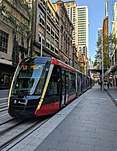

As part of the winning consortium to build and operate the CBD and South East Light Rail, Alstom supplied sixty Citadis X05 trams.[40] Each vehicle will consist of five-sections. The trams are coupled together to operate in pairs of two.[41] Original plans for the line intended for the trams to be approximately 45 metres long and operate as single units. Wire-free operation in a section of George Street between Bathurst Street and Circular Quay was to be achieved via battery storage.[42][43] In December 2014, it was announced that Alstom's proprietary Aesthetic Power Solution ground-level power supply technology would be used in place of batteries. The length of the trams would also be reduced, but they would now operate in pairs, giving each pair a total length of approximately 67 metres.[44]
The first unit was completed in May 2017.[45][46] The first six were manufactured in La Rochelle, France, the remaining 54 in Barcelona, Spain.[47] They are numbered 001-060.
Withdrawn
Variotram
The network's original rolling stock was the Variotram which was introduced with the opening of the first section of the Inner West Light Rail in 1997. Seven German-designed vehicles were manufactured by Adtranz in Melbourne.[48] The Variotram design is modular and was extended for the Sydney system. The capacity of the vehicles was 217 passengers, of which 74 were seated.[49] The first was damaged in an accident near 🌍 while on its delivery run and had to be returned to Melbourne for repairs.[50] On tests up to three trams were coupled together allowing a maximum capacity of 600 passengers if required.[48] They were numbered 2101–2107, continuing the Sydney trams sequence that finished at 2087 with the last Sydney R1-Class Tram.
The vehicles had a floor to rail height of 30 centimetres and the bogies had no axles between the wheels and were powered with hub motors.[48] The design weight was reduced to compensate for the addition of climate-control air-conditioning equipment. Each was fitted with three double doors each side which had enhanced safety systems with obstacle detection interlocked with the traction system.[48] Seats were generally in the transverse configuration – at 90 degrees to the sides of the vehicle. In 2014, the original external destination rolls were replaced with dot-matrix displays and digital voice announcements were installed. There were no internal displays. The last Variotram was withdrawn from service after operating overnight between Central and The Star on 27/28 May 2015.[51]
After sustaining damage in a derailment at Glebe on 7 October 2013, Variotram number 2106 was scrapped.[52] The remaining six Variotrams were placed into store in Penrith during the first half of 2015. Having been retained by Transport Heritage NSW, in October 2018, 2107 was placed in the custody of the Sydney Tramway Museum, Loftus.[53] The remaining five (2101–2105) were scrapped in early 2018.[54]
Urbos 2

Four leased Urbos 2 trams were introduced on the Inner West Light Rail in 2014. They entered service to coincide with the extension of the line to Dulwich Hill, supplementing the Variotrams and ensuring service frequencies on the line could be maintained. The four trams had previously operated in Spain. Three units (2108–2110) were from Vélez-Málaga, where they operated between 2006 and 2012.[55] The other tram (2111) was from Seville. The first Urbos 2 arrived in Sydney on 4 September 2013.[56] Delivery was completed in November. The trams entered service on 22 March 2014, five days before the opening of the extension to Dulwich Hill.[57] Following the introduction of the Urbos 3 trams in July 2014, the Urbos 2s were withdrawn and returned to Spain.[33] The Urbos 2s were unpopular with passengers and attracted complaints.[58]
The trams featured four double and two single doors on each side. The seats were unpadded and were generally built in the longitudinal seating configuration – running parallel to the sides of the vehicle's body. Digital voice announcements and internal dot-matrix displays provided information about the next stop.
Patronage
The following table lists patronage figures for the network during the corresponding financial year. Australia's financial years start on 1 July and end on 30 June. Major events that affected the number of journeys made or how patronage is measured are included as notes.
| Year | 2010–11 | 2011–12 | 2012–13 | 2013–14 | 2014–15 | 2015–16 | 2016–17 | 2017–18 | 2018–19 | 2019-20 |
|---|---|---|---|---|---|---|---|---|---|---|
| Patronage (millions) |
2.7 [lower-alpha 1] |
4.0 | 4.2 | 3.9 [lower-alpha 2][lower-alpha 3] |
6.1 [lower-alpha 4] |
9.7 | 10.0 [lower-alpha 5] |
10.3 | 10.6 [lower-alpha 6] |
12.4 [lower-alpha 7] |
| References | [59] | [60] | [61] | [62] | [63] | [64] | ||||
 | ||||||||||
- Partial integration with main Sydney ticketing system in June 2011
- Services suspended for much of October 2013 after double derailment
- Dulwich Hill extension opened in March 2014
- Opal introduced in December 2014
- Non-Opal tickets discontinued in August 2016
- Based on TfNSW Annual Report figure minus Newcastle Light Rail Opal tap on and tap off data
- L2 Randwick Line opened in December 2019 and L3 Kingsford Line opened in April 2020. Patronage was lower than anticipated due to people staying at home and not taking public transport to school or work during the COVID-19 pandemic
| 7 767 000 |
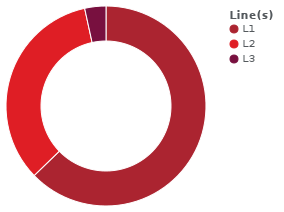 | |
| † | 4 184 000 | |
| † | 424 000 |
- Figures based on Opal tap on and tap off data.
†= L2 Randwick Line opened in December 2019 and L3 Kingsford Line opened in April 2020.
Metro |
18 892 000 |
 |
Train |
282 022 000 | |
Bus |
229 532 000 | |
Ferry |
11 083 000 | |
Light Rail |
12 374 000 |
Ticketing and fares
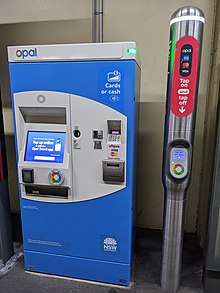
The smartcard-based Opal Card ticketing system, which was introduced to the network on 1 December 2014 is valid on bus, light rail, train and ferry services.[67] Different fares apply for these modes, except that the same fares apply to light rail and buses. However, they are treated as separate modes for fare calculation purposes.[68] Light rail stops feature Opal top-up machines that also sell Opal single trip tickets. The single trip tickets are more expensive than the standard Opal fare. They are only valid for travel on light rail and must be used on the day of purchase.[69] The following table lists Opal fares for reusable smartcards and single trip tickets[70]
| As of 6 July 2020 | 0–3 km | 3–8 km | 8 km+ |
|---|---|---|---|
| Adult cards & contactless (peak) | $3.20 | $3.73 | $4.80 |
| Adult cards & contactless (off-peak) | $1.60 | $1.86 | $2.40 |
| Other cards (peak) | $1.60 | $1.86 | $2.40 |
| Other cards (off-peak) | $0.80 | $0.93 | $1.20 |
| Adult single trip | $4.00 | $4.60 | $6.00 |
| Child/Youth single trip | $1.40 | $2.30 | $3.00 |
Fares are calculated using straight line distance between the origin and destination stops. No two stops on the existing line are located more than eight kilometres from each other using this method, so the 8 km+ band doesn't apply to light rail services.
When it first opened, the Inner West Light Rail used its own paper-based ticketing system. Paper tickets were originally sold from ticket machines on stop platforms but were later issued by conductors on board. During the 2010s, this system gradually merged with the broader Sydney ticketing system, culminating in the introduction of Opal and the withdrawal of all other tickets. This process was completed on 1 August 2016.[71]
Potential extensions
Several transport corridors have significant potential to allow for the growth of the network beyond its current route structure.
Anzac Parade

The New South Wales Government's 2012 policy document entitled Sydney's Light Rail Future proposed investigating an extension of the CBD and South East Light Rail along the southern Anzac Parade corridor.[72]
By 2014, an initial investigation had commenced. Three potential options were examined; a 1.9 kilometre extension to Maroubra Junction, a 5.1 kilometre extension to Malabar and an 8.2 kilometre extension to La Perouse.[73]
The government's 2018 Greater Sydney Services and Infrastructure Plan included a proposal for an extension to Maroubra Junction. The extension wouldn't be developed for at least 10 years.[74]
The Bays Precinct
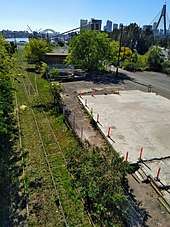
The Bays Precinct is a large waterfront area to the west of the Sydney CBD being proposed for urban renewal by the New South Wales Government. The southern part of the precinct is served by the existing Inner West Light Rail. A planning document released by the government in October 2015 suggested light rail could be extended to the northern part of the precinct, possibly utilising the Glebe Island Bridge.[75]
The government's 2018 Greater Sydney Services and Infrastructure Plan included a proposal for a new line from Leichhardt North to Pyrmont via The Bays Precinct and the Glebe Island Bridge. It would connect with the existing Inner West Light Rail at both ends. The line wouldn't be developed for at least 10 years.[74]
Parramatta Light Rail extensions
The New South Wales Government's 2012 policy document entitled Sydney's Light Rail Future proposed investigating a Western Sydney light rail network.[72] This led to a number of corridors being investigated in the early planning stages of the Parramatta Light Rail project. The final corridors selected for development were announced in 2015.
In early 2017, Transport for NSW had begun an investigation into an extension of the Parramatta Light Rail from Carlingford to Epping.[76]
The government's 2018 Greater Sydney Services and Infrastructure Plan proposed investigating unspecified extensions to the network. The extensions wouldn't be developed for at least 10 years.[74]
Green Square
In 2012, the City of Sydney Council recommended that a Light Rail link be built from the city to Green Square, to service the commercial and residential developments being built in the area, which is expected to become Australia's most densely populated precinct. The council has spent more than $30 million buying land for a light rail corridor.[77][78][79] In July 2015, New South Wales Transport Minister Andrew Constance stated that the area was likely to be served by a light rail link in the future.[80] This led to a decision in October by the City of Sydney to allocate $445,000 to develop plans for a light rail line from the city to Green Square. The council estimated a link would cost $350–500 million to build.[78]
Bondi
In 2011, Waverley Council advocated for the extension of the light rail network to link the current infrastructure to Bondi Junction and Bondi Beach.[81][82] The council commissioned AECOM to undertake a feasibility assessment of the reintroduction of light rail on the corridor between Bondi Beach and Bondi Junction (Stage 1) and onto the CBD (Stage 2) to achieve mass transit of passengers and requested Transport for NSW consider the CBD to Bondi Beach corridor as a priority route in the Sydney Light Rail Plan.[83]
See also
- List of tram and light-rail transit systems
- Newcastle Light Rail
- Public transport in Sydney
- Railways in Sydney
Notes
References
- "Sydney's new light rail opens 14 December from Circular Quay to Randwick". Transport Info NSW. Archived from the original on 9 December 2019. Retrieved 5 December 2019.
- "Sydney Inner West Light Rail Construction and Extension, Australia". Retrieved 6 December 2019.
- "Nominated Loan Council Allocations For 1998–99". The Australian Treasury Website. 7 May 1998. Archived from the original on 6 April 2016. Retrieved 12 December 2015.
- "Sydney Light Rail Extension – Stage 1 Inner West Extension Product Definition Report" (PDF). Transport NSW. July 2010. Archived from the original (PDF) on 7 April 2014.
- Mills, Gordon (1997). "Light Rail in Sydney: Some Privatisation Lessons" (PDF). Agenda. 4 (4): 435, 438.
- Mills, Gordon (1997). "Light Rail in Sydney: Some Privatisation Lessons" (PDF). Agenda. 4 (4): 433–444. Archived (PDF) from the original on 2 October 2019. Retrieved 2 October 2019.
- "Stock Exchange Announcement". Hastings. 11 August 1998. Archived from the original on 10 July 2015. Retrieved 6 April 2019.
- "TNT Annual Report 1998 – Non-core business". TNT. Archived from the original on 13 April 2014. Retrieved 27 September 2019.
- "Light rail in Sydney". Transdev. Retrieved 14 July 2016.
- "Overview of Connex Worldwide and in Australia". Metro Light Rail. Archived from the original on 25 April 2003. Retrieved 1 February 2018.
- "Technical Details (Metro Monorail)" (PDF). Metro Transport Sydney. 2005. Archived from the original (PDF) on 27 January 2005. Retrieved 1 February 2018.
- Cosgriff, Stuart; Griffiths, Emily (5 July 2012). "Light rail strategy for Sydney". Clayton Utz Insights. Clayton Utz. Retrieved 6 July 2012.
- Campion, Vikki (23 March 2012). "Last stop for Sydney Monorail". The Daily Telegraph.
- Tan, Gillian (23 March 2012). "Australian Infrastructure Fund sells Metro Transport stake". The Australian (from The Wall Street Journal).
- Saulwick, Jacob (18 April 2013). "All together now: Sydney's public transport united under one 'brand'". The Sydney Morning Herald. Retrieved 5 April 2015.
- "Transport for NSW 2013/14 Annual Report" (PDF). Transport for NSW. pp. 329, 344. Archived from the original (PDF) on 5 December 2014. Retrieved 1 January 2015.
- Delivering an integrated light rail system: ALTRAC takes over operation of inner west light rail Archived 6 July 2015 at the Wayback Machine Transport for NSW 2 July 2015
- "CBD and South East Light Rail contract awarded with earlier delivery date". Transport for NSW. 18 December 2014. Archived from the original on 18 December 2014.
- "Transdev consortium achieves financial close on Sydney Light Rail PPP" (Press release). Transdev. 25 February 2015. Archived from the original on 11 April 2015. Retrieved 5 April 2015.
- "Transdev Australasia consortium secures Parramatta Light Rail contract" (PDF). Transdev Australasia. 20 December 2018.
- "Sydney's new light rail system". Railway Digest. September 1997. p. 14.
- "Sydney's Tram Extension Opens". Railway Digest. September 2000. p. 4.
- "Inner West Light rail extension now complete". Transport for NSW. 27 March 2014. Archived from the original on 27 March 2014.
- Final stage of Sydney's CBD light rail opens Sydney Morning Herald 3 April 2020
- Sydney’s new light rail is now open from Circular Quay to Kingsford Transport for NSW 3 April 2020
- "Final countdown to construction: Sydney Light Rail major works start October 23". Transport for NSW. 28 May 2015.
- "Parramatta Light Rail – Stage 1: frequently asked questions" (PDF). Transport for NSW. Retrieved 17 February 2017.
- "Preferred route – stage 1" (PDF). Transport for NSW. Retrieved 17 February 2017.
- "Parramatta light rail extension to Olympic Park on the Way". Transport for NSW. Retrieved 19 October 2017.
- "LRV's of the Sydney Light Rail Inner West Extension | www.engineersaustralia.org.au". www.engineersaustralia.org.au. Retrieved 9 February 2018.
- "Contract awarded for delivery of new light rail vehicles". Transport for NSW. Retrieved 16 August 2012.
- O'Rourke, Jim (20 December 2013). "Sneak peek at Sydney's new trams". The Daily Telegraph. Retrieved 20 December 2013.
- First new light rail vehicle on the tracks as customer trips pass 1.5 million Archived 8 August 2014 at the Wayback Machine, Transport for NSW, Retrieved 23 July 2014
- "Six more new light rail vehicles for Sydney". Transport for NSW. Archived from the original on 2 December 2013. Retrieved 11 October 2013.
- "Inner West Light Rail extension celebrates first year as new light rail vehicles go into operation" (Press release). Gladys Berejiklian. 27 March 2015. Archived from the original on 6 April 2015. Retrieved 5 April 2015.
- "Sydney Tram". CAF. Retrieved 1 March 2013.
- "Inner West Light Rail Capacity" (PDF). Sydney Morning Herald. Transport for New South Wales. Retrieved 29 August 2017.
- "Parramatta Light Rail contracts signed". www.transport.nsw.gov.au. Transport for NSW. 20 December 2018.
- "CAF consortium secures Parramatta Light Rail contract in New South Wales (Australia)". Construcciones y Auxiliar de Ferrocarriles. 20 December 2018. Retrieved 27 December 2018.
- "Alstom to deliver to Sydney Citadis X05, the latest evolution of its tram range" (Press release). Alstom. February 2015. Retrieved 25 February 2015.
- "Sydney is first Citadis X05 tram customer". Metro Report International. 25 February 2015. Retrieved 12 June 2017.
- Dean, Emma; Moore, Adam; Bunting, Kathleen (Parsons Brinckerhoff Australia) (21 June 2013). "CBD and South East Light Rail – State Significant Infrastructure Application Supporting Document" (PDF). Transport for NSW. pp. 4, 23. Archived from the original (PDF) on 27 September 2013. Retrieved 12 July 2013.CS1 maint: multiple names: authors list (link)
- "CBD and South East Light Rail – Industry Briefing Session" (PDF). Transport for NSW. 9 April 2013. p. 11. Retrieved 10 April 2013.
- "CBD and South East Light Rail – Modification Report" (PDF). Transport for NSW. pp. 25, 66. Retrieved 3 December 2014.
- Alstom completes first Citadis X05 LRVs for Sydney International Railway Journal 24 May 2017
- First Citadis X05 tram rolled out Metro Report International 24 May 2017
- "Here & There" Trolley Wire issue 331 November 2017 page 12
- "Sydney Light Rail Construction and Extension". Railway Technology.
- "Technical Details and All That Stuff..." (PDF). Metro Transport Sydney. Archived from the original (PDF) on 15 February 2012. Retrieved 2 July 2013.
- Accident to New Sydney Tram Trolley Wire issue 269 May 1997 page 23
- Sydney Light Rail Vlog 25: Vario Trams: The End Of An Era. 28 May 2015.
- Sydney's light rail extension opens Trolley Wire issue 337 May 2014 page 22
- Sydney Variotram 2107 arrives at Loftus Sydney Tramway Museum
- Preservation & Tourist Railway Digest November 2018 page 52
- "Sydney to lease Velez-Malaga LRVs". International Railway Journal. Retrieved 17 May 2013.
- Walker, Ian (4 September 2013). "Early morning tram delivery brings George St to a halt". The Daily Telegraph. Retrieved 4 September 2013.
- Inner West Light Rail Extension opens next week Archived 21 March 2014 at the Wayback Machine Transport for NSW 21 March 2014
- "Transport for NSW 2013/14 Annual Report" (PDF). Transport for NSW. 4 April 2014. p. 45. Archived from the original (pdf) on 5 December 2014.
- "Transport for NSW Annual Report 2013-14" (PDF). Transport for NSW. p. 395. Archived from the original (PDF) on 29 May 2015. Retrieved 1 August 2016.
- "Transport for NSW Annual Report 2014-15" (PDF). Transport for NSW. p. 131. Retrieved 1 August 2016.
- "Light Rail Patronage". Transport Performance and Analytics – Transport for NSW. December 2016. p. Top Level Charts. Retrieved 27 December 2016.
- "Annual Report 2016-17" (PDF). Transport for NSW. p. 16. Retrieved 24 November 2017.
- "Transport for NSW Annual Report 2017-18" (PDF). Transport for NSW. p. 17. Retrieved 2 December 2018.
- "Light Rail Patronage – Monthly Comparison". Transport for NSW. Retrieved 1 March 2020.
- "Light Rail Patronage - Monthly Comparision". Transport for NSW. Retrieved 7 August 2020.
- See Transport for NSW patronage in Sydney by mode for sources
- "Opal to go live on light rail months ahead of schedule". Transport for NSW. 24 November 2014. Archived from the original on 1 December 2014. Retrieved 24 November 2014.
- http://www.transportnsw.info/sites/en/transport-status/news/2014/opal-rollout.page Opal rollout extends to light rail Archived 6 October 2014 at the Wayback Machine Transport Info NSW 25 November 2014
- "Opal single trip tickets". Transport for NSW. Retrieved 4 August 2019.
- "Opal fares". transportnsw.info. Transport for NSW. Retrieved 22 June 2019.
- "The last paper tickets to be wrapped up on August 1". Transport for NSW. 4 July 2016. Archived from the original on 6 July 2016.
- "Sydney's Light Rail Future" (PDF). Transport for NSW. 13 December 2012. p. 20. Retrieved 17 March 2017.
- "2014 State Infrastructure Strategy Update" (PDF). Infrastructure NSW. p. 40. Archived from the original (PDF) on 29 November 2014.
- "Greater Sydney Services and Infrastructure Plan" (PDF). Transport for NSW. March 2018. pp. 196, 203. Retrieved 19 March 2018.
- Saulwick, Jacob (22 October 2015). "Return of trams to Glebe Island Bridge floated in inner harbour overhaul". The Sydney Morning Herald.
- "Parramatta Light Rail – Stage 1: frequently asked questions" (PDF). Transport for NSW. Retrieved 17 February 2017.
- "Light Rail". City of Sydney. Archived from the original on 6 October 2012.
- "Green Square light rail moves another step closer". sydneymedia.com.au. City of Sydney. 30 October 2015.
- O'Sullivan, Matt (21 November 2018). "'Transport mess': Passengers at one Sydney station nearly double in three years". The Sydney Morning Herald.
- Saulwick, Jacob (28 July 2015). "Green Square needs light rail, Transport Minister says in break from past". The Sydney Morning Herald. Retrieved 28 July 2015.
- "Waverley Transport Plan". Waverley Council. December 2011. Archived from the original on 22 February 2014. Retrieved 3 April 2020.
- Paperny, Daniel (11 October 2012). "Light rail on track for Bondi". CityHub Sydney. Retrieved 3 April 2020.
- "URGENT BUSINESS FOR CONSIDERATION" (PDF). Waverley Council. 21 May 2013. Retrieved 3 April 2020.
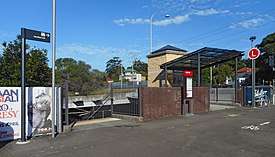
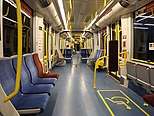
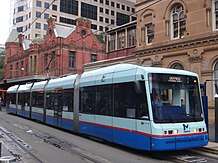
.jpg)